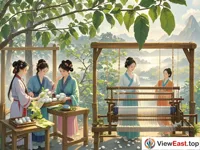

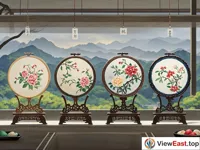
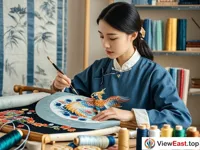
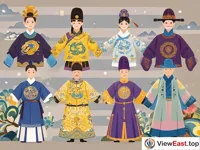
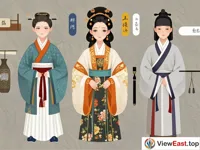

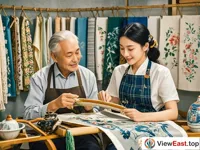
Introduction
The culture of ancient Chinese clothing is an essential part of Chinese civilization. From the smooth delicacy of silk to the exquisite beauty of embroidery, ancient Chinese clothing is not only practical but also a reflection of art and aesthetics. They are witnesses of history and carriers of culture.
Silk: The Magnificent Chapter of Clothing
Silk, one of China's ancient and famous inventions, marks a leap in the culture of clothing. With its unique texture and luster, silk became the exclusive domain of nobility and the royal court.
The Origin of Silk
The origin of silk dates back to the time of the Yellow Emperor. Legend has it that the Yellow Emperor's wife, Leizu, invented the technology of sericulture and silk weaving. Since then, silk has become an important commodity for China's foreign exchanges and a vital cargo on the Silk Road.
The Craft of Silk
The production process of silk is complex and meticulous, requiring exceptional skill from sericulture to silk reeling and weaving. There are various types of silk, such as satin, gauze, and brocade, each with its unique style and purpose.
Embroidery: The Beautiful Art between Needles and Threads
Embroidery is a traditional Chinese folk craft that uses needles as brushes and threads as colors to create various patterns on silk or other fabrics.
The Four Famous Embroideries
The four famous Chinese embroideries include Suzhou embroidery, Guangdong embroidery, Hunan embroidery, and Sichuan embroidery. Each embroidery technique has its unique style and skill. Suzhou embroidery is known for its delicate elegance, Guangdong embroidery for its bright colors, Hunan embroidery for its freehand style, and Sichuan embroidery for its varied stitches and rich, magnificent colors.
Patterns in Embroidery
The patterns of embroidery are rich and colorful, ranging from flowers, birds, fish, and insects to human stories, geometric designs, and natural scenery. Each pattern has its specific meaning and symbolism.
The Aesthetics of Ancient Chinese Clothing
The aesthetics of ancient Chinese clothing pursue harmony, balance, and nature. The design and decoration of clothing not only consider beauty but also conform to the wearer's status and occasion.
Colors in Clothing
There are strict hierarchical regulations for the colors of clothing, such as the bright yellow used exclusively by the royal family, the purple and red for officials, and the blue and white for commoners. Colors represent not only status but also aesthetics.
Styles in Clothing
The styles of clothing are diverse, from the loose robes of Hanfu to the gorgeous and solemn Tang suits. Each style reflects the aesthetic taste and social customs of different dynasties.
Conclusion
Silk and embroidery are treasures in the culture of ancient Chinese clothing. They showcase not only the craftsmanship of ancient China but also the wisdom and aesthetic taste of the Chinese people. Gaining an in-depth understanding of these traditional crafts allows us to better comprehend Chinese culture and find inspiration in modern fashion.
Exploring the aesthetics and craftsmanship of ancient Chinese clothing, we can learn how to integrate traditional elements into modern design; studying silk and embroidery, we can learn how to seek beauty and harmony in a fast-paced life. The essence of these traditional crafts is not only the inheritance of skills but also the transmission of culture.